
Radon: A Tracer for Geological, Geophysical and Geochemical Studies
Springer International Publishing (Verlag)
978-3-319-21328-6 (ISBN)
Dr. Mark Baskaran is a tenured Full Professor in the Department of Geology at Wayne State University (Detroit, Michigan). He received his Ph.D. in Physics from Physical Research Laboratory (PRL), a premier research institution in India. After his Ph.D., he spent 2 years at PRL as a postdoctoral fellow before he moved to the Institute of Marine Science at the University of Alaska (Fairbanks, Alaska). After a year, he joined Texas A&M University (Galveston, Texas) where he taught introductory Physics and Geology courses at the Department of Marine Sciences, while conducting research related to atmospheric fluxes of radionuclides, mobility of radionuclides in groundwater, scavenging and particle cycling in marine environment and dating of recent sediments and carbonates. After his eleven year career as a teacher and researcher in Texas, he joined Wayne State University where he became a tenured Full Professor in 2007. He teaches both introductory level courses in Oceanography, Meteorology, and Physical Geology as well as upper level courses including Chemical Fate and Transport in the Environment, Nuclear Geology and Environmental Geochemistry. Prof. Mark Baskaran has published over 130 peer-reviewed articles (with over 5,100 Google Scholar cumulative citations, h-index 43 in February 2016), most of which are related to the applications of isotopes as tracers and chronometers in Earth systems. He edited a two-volume Handbook entitled “Handbook of Environmental Isotope Geochemistry” with forty articles contributed by eminent scholars in the field in 2011, published by Springer. He spent three months as a Senior Fulbright Scholar at Ege University (Izmir, Turkey) in 2015. He has given invited and plenary talks/seminars at over sixty national/international conferences, workshops, universities and research institutions around the world. Dr. Baskaran’s research work includes all subsystems of the Earth system. Most of his work involved collaboration with a large number of researchers from universities and institutions around the world. His work with marine systems (estuarine, coastal, shelf and open-ocean) on the investigations of particular organic carbon export, particle cycling and remineralization and colloidal thorium scavenging in the Arctic Ocean, Gulf of Mexico, North Atlantic and East Pacific were funded by several funding agencies in the U.S. that include the National Science Foundation (NSF), National Oceanic and Atmospheric Administration (NOAA), and the Department of Energy (DOE). His currently funded ongoing research is to investigate sedimentation and sediment dynamics in dams and other freshwater systems. He has been funded by NSF as a part of the U.S. GEOTRACES group in all four phases (Intercalibration, North Atlantic, East Pacific and Western Arctic Ocean sections). He has served as a Chief Scientist in six major oceanographic expeditions in the Gulf of Mexico and Arctic Ocean. He convened a National Workshop entitled “Recent Changes in the Biogeochemistry of the Great Lakes System” in March 2013 at Wayne State University. He also had convened a number of sessions and meetings at both national and international conferences and workshops.
Physical, Chemical and Nuclear Properties of Radon: An Introduction.- Radon Measurement Techniques.- Mechanisms of Radon Emanation and Long-Term Radon Flux Studies.- Radon: A Tracer for Atmospheric Studies.- Applications of Radon Progeny in Atmospheric Studies.- Radon: A Geochemical and Geophysical Tracer in Marine System.- Progeny of radon ( 210 Pb) as a tracer and chronometer in continents and aqueous systems.- Radon in Groundwater System.- Radon: A Tracer for Geochemical Exploration.- Radon as a Tracer for Earthquake Studies.- Radon: A Human Health Hazard in the Environment.
"If you have any interest in the study of randon or think that you may have a future interest, this book is for you. This is a book that I can recommend without reservation. I was impressed at the broad scope of earth and medical sciences in which randon is involved. This 260-page volume is one of the more compact texts available on the subject. ... Each chapter can be considered as a standalone paper." (Patrick Taylor, The Leading Edge, Vol. 41 (10), October, 2022)
“If you have any interest in the study of randon or think that you may have a future interest, this book is for you. This is a book that I can recommend without reservation. I was impressed at the broad scope of earth and medical sciences in which randon is involved. This 260-page volume is one of the more compact texts available on the subject. … Each chapter can be considered as a standalone paper.” (Patrick Taylor, The Leading Edge, Vol. 41 (10), October, 2022)
| Erscheint lt. Verlag | 19.8.2016 |
|---|---|
| Reihe/Serie | Springer Geochemistry |
| Zusatzinfo | XX, 260 p. 76 illus., 27 illus. in color. |
| Verlagsort | Cham |
| Sprache | englisch |
| Maße | 155 x 235 mm |
| Themenwelt | Medizin / Pharmazie ► Medizinische Fachgebiete ► Arbeits- / Sozial- / Umweltmedizin |
| Naturwissenschaften ► Biologie ► Ökologie / Naturschutz | |
| Naturwissenschaften ► Geowissenschaften ► Geologie | |
| Schlagworte | Atmospheric Tracer • Radon • Radon as Oceanographic Tracer • Radon Daughter Products • Radon Human Health Issues • U and Hydrocarbon Exploration Tool |
| ISBN-10 | 3-319-21328-8 / 3319213288 |
| ISBN-13 | 978-3-319-21328-6 / 9783319213286 |
| Zustand | Neuware |
| Haben Sie eine Frage zum Produkt? |
aus dem Bereich


